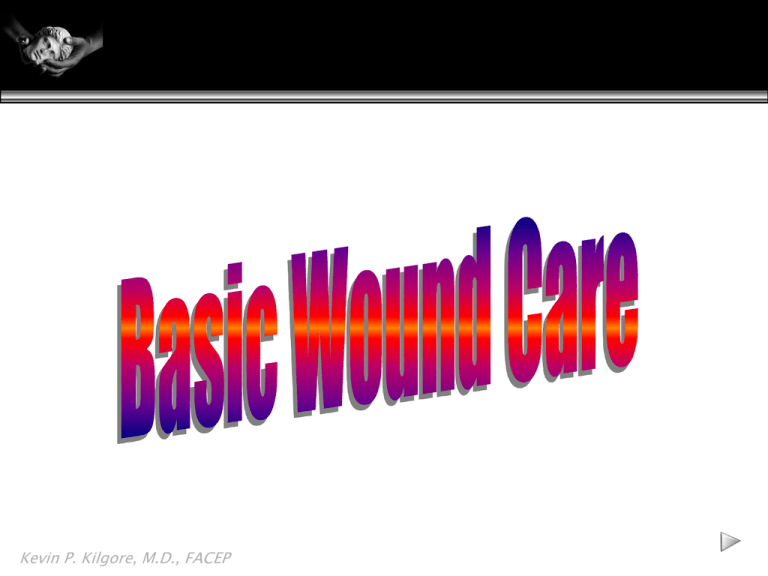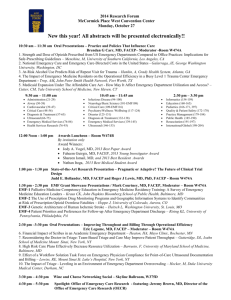Basic Wound Care Power Point - MN
advertisement

Kevin P. Kilgore, M.D., FACEP Overview The process of wound care involves evaluation plan action Kevin P. Kilgore, M.D., FACEP Objectives Objectives Discuss the process of wound evaluation Review the materials used for wound repair Discuss “simple” wound closure Discuss wound aftercare items Kevin P. Kilgore, M.D., FACEP History When did this happen? Where did this happen? time location How did this happen? mechanism Kevin P. Kilgore, M.D., FACEP History allergies current medications pre-existent medical conditions immunization status for tetanus Kevin P. Kilgore, M.D., FACEP History The “golden period” A misnomer with: meticulous debridement copious irrigation antibiotic coverage Kevin P. Kilgore, M.D., FACEP History Mechanism shear tension compression missile injuries a combination of shear, tensile, and compressive Kevin P. Kilgore, M.D., FACEP History Shear Kevin P. Kilgore, M.D., FACEP Sharp tissue division Little energy required Lower infection rate Cosmetics acceptable History Tension Kevin P. Kilgore, M.D., FACEP Compression injury Less than 90o Triangular flap Increased infection Poor result History Compression Kevin P. Kilgore, M.D., FACEP Crushing injury Significant injury Increased infection Poor results Examination Environment protective dressing gloves, gowns, goggles good lighting goal - determine extent of injury Kevin P. Kilgore, M.D., FACEP Examination Extent of injury amount of tissue loss tissue viability depth of the wound presence of any associated injuries Kevin P. Kilgore, M.D., FACEP Examination Depth of injury Injury to underlying structures? nerves tendons muscles bone Kevin P. Kilgore, M.D., FACEP Examination Lacerations over bones probe with a gloved finger to determine whether or not there is a fracture. If a wound overlies a fracture site an open fracture should be assumed present. Kevin P. Kilgore, M.D., FACEP Examination Deep structure injury puncture wounds of the head, neck and torso must be managed on the premise that there has been penetration and damage to vital structures. Kevin P. Kilgore, M.D., FACEP Techniques Anesthesia Topical Local TAC or XAP 1% buffered xylocaine bupivocaine Regional (nerve block) 1% buffered xylocaine bupivocaine Kevin P. Kilgore, M.D., FACEP Techniques Irrigation & debridement The single most important element of basic wound care. Intent: remove devitalized tissue remove potential nidus for infection Kevin P. Kilgore, M.D., FACEP Techniques Preparation Generally, an iodophor solution (e.g., Betadine 10%) Sterile draping is imperative Kevin P. Kilgore, M.D., FACEP Techniques Instruments four basic instruments needle-holder forceps scissors towels Kevin P. Kilgore, M.D., FACEP Techniques Suture materials Absorbable Sutures employed below the skin Polyglycolic acid (Dexon®) Nonabsorbable Sutures nylon (dermalon®, ethilon®) surgelene® novifyl® Kevin P. Kilgore, M.D., FACEP Techniques Other closure materials Steri-Strips® and Shur-strips® Surgical staples Dermabond Kevin P. Kilgore, M.D., FACEP Techniques Size Selection face, hands or feet - 5-0 and 6-0 trunk and extremity - 4-0 and 5-0 Kevin P. Kilgore, M.D., FACEP Techniques Suture techniques Subcuticular Closure Dexon® or Vicryl®, are used for this deep layer closure. Cuticular Closure Kevin P. Kilgore, M.D., FACEP Techniques Subcuticular Closure Kevin P. Kilgore, M.D., FACEP Techniques Simple Suture Kevin P. Kilgore, M.D., FACEP easiest to learn safest & most effective more time needed Techniques Wound Edge Eversion Kevin P. Kilgore, M.D., FACEP Techniques Instrument Tie Kevin P. Kilgore, M.D., FACEP Completing Care Dressings Immobilization Medications Antibiotics Tetanus Prophylaxis Rabies Prophylaxis Discharge Instructions Kevin P. Kilgore, M.D., FACEP Completing Care Suture Removal face ear scalp trunk arms legs hand feet 3 to 5 days 4 to 6 days 7 to 12 days 7 to 12 days 10 to 12 days 10-12 days 10 to 12 days 10 to 14 days Kevin P. Kilgore, M.D., FACEP Objective Review Discuss the process of wound evaluation Review the materials used for wound repair Discuss “simple” wound closure Discuss wound aftercare items Remember to remove your sharps from the tray Kevin P. Kilgore, M.D., FACEP Now to the Lab








